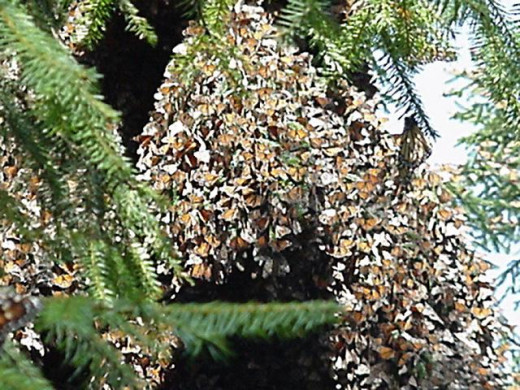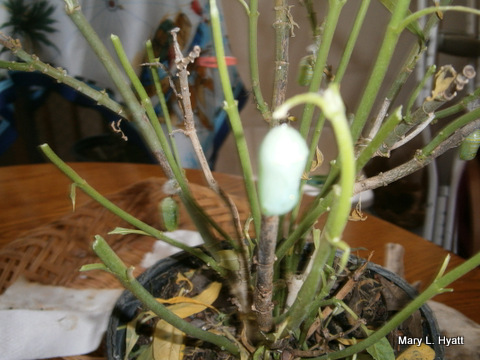- HubPages»
- Education and Science»
- Life Sciences»
- Entomology»
- Insects & Bugs
Bring Back The Monarch Butterflies By Planting Milkweed In Your Garden.

I love all butterfies, but the Monarch is my favorite. I am doing my part to keep them as part of our environment.
I grow Milkweed in my yard to give these butterflies a place to lay their eggs. Anyone can do this.
I hope after reading this article, you will join me and many others in helping to preserve the Monarch butterfly.
Monarchs Migrate To Central Mexico
Every year, hundreds of millions of monarch butterflies – each so light that 50 together weigh barely an ounce – find their way on what may be the world’s longest insect migration, travelling the length of North America to pass the winter in central Mexico.
Some of these trees are literally covered with Monarchs! Can you imagine hearing all those delicate wings fluttering at once? That is a sight I would love to see!
This photo shows millions of Monarchs in a tree in central Mexico.
Monarchs overwintering Angangueo site in Mexico

Monarch Butterflies Are In Danger!
The Monarchs are in danger. The Monarchs feed on a plant called Milkweed. Milkweed is a broad-leafed plant. The Monarchs need this plant to feed on and to lay their eggs. They cannot survive without this plant. Because of widespread use of herbicides used on farms and along highways to kill the weeds, Milkweed is being killed off.
Monarchs can’t survive without milkweed. Female monarchs lay eggs on milkweed. When they hatch, the larvae grow into caterpillars that feed on the milkweed’s leaves. Those leaves contain a poison that inoculates the monarchs from their predators. The caterpillars then form chrysalises and emerge as butterflies.
Spraying Crops Has Killed Off The Milkweed
The advent of genetically modified corn and soybean varieties that can withstand herbicides has added to the demise of the Monarch. Now farmers employ glyphosate herbicides that kill weeds with a vengeance. It’s had a huge impact on milkweed. Before all this spraying began Milkweed could grow among crops or at the edges of fields.
Crops can survive this spraying, but Milkweed cannot survive.
Most monarchs live only a little more than a month. But one generation each year lives seven or eight months, long enough to migrate to central Mexico before winter sets in, where the butterflies settle into a semi-dormant state, often clustering around the same trees as their forebears, perhaps drawn by chemical cues.
In the spring, the monarchs return to the north, where they lay eggs on milkweed, giving way to a new generation.
I Urge People To Plant Milkweed
People should be encouraged to plant Milkweed to serve as a stopping place for the butterflies as they migrate.
Our local, state and federal governments need to be urged to allow the Milkweed to grow undisturbed along highways instead of mowing it down, or worse: using herbicide on the weeds.
Buy Milkweed Plants Or Seed
You can purchase Milkweed plants or buy the seeds. The seeds come up rapidly and will produce many plants.
The Four Stages Of The Butterfly
In order to understand how this miracle of nature works, one should have a basic knowledge of the cycle of the Butterfly.
In the first stage, a mature butterfly lays her tiny, sticky egg on the leaf of a plant. The egg is sticky so it can’t fall off the leaf. If you can imagine, the egg is the size of the head of a straight pin . This egg will soon become a caterpillar. It is hard to imagine this green caterpillar with it’s brightly marked, bold pattern will soon become a butterfly! Some of these caterpillars can be up to six inches long. Not all caterpillars are butterfly larvae.
The Four Stages Are:
Egg
Caterpillar
Cocoon (Pupa)
Finally, the Butterfly emerges
My Method of Hatching Monarch Butterflies
This is the method I have used to study the Monarch butterfly:
- Use a stick and carefully remove a caterpillar from the plant.
- Place the caterpillar it in a glass jar that you have made holes in the top for air.
- Place some leaves of the same plant the caterpillar came from in the jar.
- Add a few drops of water.
- Every day, place fresh leaves and more water inside the jar.
- You will be able to observe the caterpillar weaving it’s delicate cocoon.
- Soon you will notice movement within the cocoon.
- In about two weeks, the butterfly will emerge from the cocoon.
- He has to have time to dry his wings.
- He is now ready to be released into the world!
This entire process usually takes two weeks, depending on the species of the Butterfly.
A Video Of A Monarch Emerging From The Chrysalis
Please take a minute and watch this video of a Monarch emerging from the Chrysalis. Listen to the to excitement of the children as they watch this miracle.
The Milkweed Plant

Eggs From The Monarch And Some Caterpillars

A Monarch Cocoon Hanging From The Plant

A Monarch Has Emerged And Is Resting On The Milkweed Plant

A Cocoon Is Placed Inside A Jar

This Monarch Has Emerged And Is Drying His Wings On My Blue Orchid

The Monarch Soon Flew Onto Another Plant

Would you be interested in helping to preserve the beautiful Monarch?
Preservng The Monarch Is A Wonderful Project For Children
This is such a wonderful project to share with children. After taking my four children to a Butterfly Garden once, they wanted to know more about Butterflies.
They went to the library and got books on Butterflies and studied them.
Now, after being involved in this project, they have a complete understanding of the wonderful world of Butterflies.
It was very exciting to see this Monarch drying his wings on my Blue Orchid plant.
The experience of hatching out Monarch butterflies is very rewarding. I would encourage readers to go to your local plant nursery and buy some milkweed plants. If you cannot find them locally, they can be ordered from online plant nurseries.
It is very exciting and rewarding to see a fully developed beautiful Monarch butterfly released because of our action to save them.
Oh, and did you know: the Butterfly is classified as an INSECT??
An excellent Hub by suzettenaples about the migration of the Monarch Butterfly
- The Incredible Journey of the Monarch Butterflies
The round-trip journey that the Monarch butterflies make each autumn and spring is only done by every 4th generation of Monarchs.
A Hub I wrote showing the life cycle of the Butterfly
- The Life Cycle Of The Butterfly: Photos And Video
We learn to appreciate the beauty of all the Butterflies; especially the Monarch and the Zebra Longwing, (official Butterfly of Florida).








